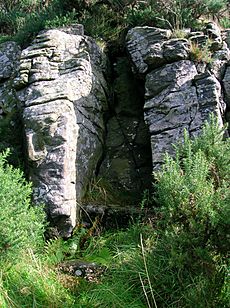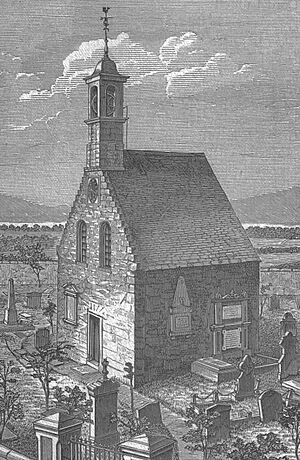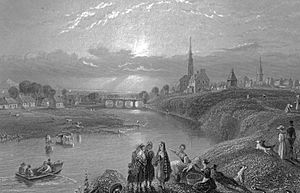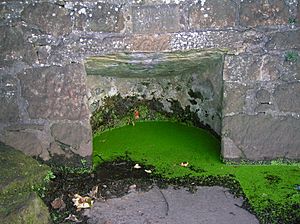Saint Inan facts for kids
Quick facts for kids Saint Inan |
|
|---|---|
| Born | 9th Century, Scotland |
| Died | 9th Century Scotland |
| Venerated in | Roman Catholic Church Orthodox Church |
| Canonized | Pre-Congregation |
| Feast | 28 September |
| Patronage | Irvine, Scotland |
Saint Inan (also known as Evan) was an important saint in Irvine, Ayrshire, Scotland. People believe he lived there in the 800s AD. It is said he came from Iona, an island known for its religious history. He is thought to have died in Irvine. Many people believed that miracles happened at his tomb.
Contents
Saint Inan's Life and Travels
Saint Inan was known as a hermit, which means he lived a simple life away from others. However, old stories say he often visited the town of Beith. He liked to spend time at Cuff Hill, which has a large rocking stone and other very old monuments.
There is a special spot on Lochlands Hill called 'St. Inan's Chair'. It is a natural rock formation that people say Saint Inan used as a pulpit. A pulpit is a raised stand where a preacher gives a sermon. There was also a clear, holy well nearby, but it is now covered over.
People say Saint Inan preached to groups from his chair on the hill. He also stayed near a place called Cauldhame Cottage. At that time, not many people lived in the area. The first villages were in the thick forests around the Beith water dams. People lived there because it was safe from attacks. They could also find food from the land and fish in the lochs (lakes).
Saints often went to places where people lived. They also visited spots where people used to worship older, non-Christian gods. For example, High Bogside Farm was once called Bellsgrove. Some think this name might have come from 'Baalsgrove', linking it to old pagan worship. This would fit the idea of Saint Inan going to these places.
Holy Wells and Chapels
One important well is known as St Mary's or the Chapel Well. It is located near where a chapel for St Mary likely stood. Above the well's opening, there is a small stone sign. It says 'St Inan's Well AD 839'.
Saint Inan's chapel was once on the same spot as the old church in Beith. Later, the church was dedicated to St. Mary the Virgin instead.
After traveling to Rome and Jerusalem, Saint Inan is said to have settled in Irvine. He died there, and his tomb was visited often. This was because people believed miracles happened at his burial site.
There was also a Saint Inan's well in Fullarton, south of the harbor. Dundonald Castle once had a chapel named after Saint Inan. The name of the town Inchinnan in Renfrewshire is thought to mean "Inan's Isle."
Different Names for Saint Inan
Saint Inan's name has been spelled in many ways over time. Some of these include Evan, Innan, Inin, Innen, Enen, and Ennen. Later, people also called him Annan, Anan, Tinnan, or even Tennant.
He is remembered in place names like Southannan, near Fairlie. There was another church or chapel there that had his name. Some people even think that Saint Ninian and Saint Inan might have been the same person.
Tennant's Day Fair
Beith has an annual fair called Tennant's Day or Saint Tinnan's Day. It used to be held on the saint's feast day, August 18th. Now, it takes place in June. Long ago, the fair was held on Cuff Hill. It was famous for its shows, horse races, and horse sales.
Images for kids






